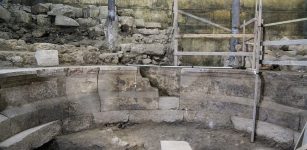Skegriedösen (Skegrie Dolmen) – 5,000-Year-Old Stone Chamber Tomb In Southern Sweden
A. Sutherland - AncientPages.com - Megalithic graves appeared more or less simultaneously in southern Sweden and were first used around 3500–3300 cal BC.
Image credit: Jorchr - CC BY-SA 3.0
Sweden has only about a hundred dolmens compared to other countries, mainly in Skåne, Halland, and Bohuslän. From the beginning, Sweden certainly possessed many more of them. Today, the existing number of these structures constitutes only a tiny part of what once existed.
No one knows precisely how these massive stones were moved and laid in their place.
Today, we visit Skegriedösen (Skegrie Dolmen) in Skegrie Parish in Trelleborg, Skåne, Sweden's most southern county. This dolmen (in Swedish - 'dös') is a stone chamber grave from the Neolithic times.
What we see today are the large boulders. All organic building materials such as reeds, birch bark, cloth, animal skins, and wood have disappeared over time.
The tombs built by the Neolithic people must have made a powerful impression once they were completed. They were then covered with smaller stones and soil like a hill. Over time, new soil layers have raised the ground level, and parts of the megalith have been hidden underground.
In the Nordic countries, a dolmen was the oldest form of a megalithic tomb. "Farmers colonized southern Scandinavia in 300-400 years from around 4000 BC. There are signs of farming before this, and the foragers may have started limited cultivation, but the change from a primarily hunter-gatherer society to a primarily farming society was rather short…" 1
Farmers colonized southern Scandinavia in 300-400 years, around 4000 BC. These stone structures were family graves of farmers. This type of Neolithic burial was laid out between 3600 and 3350 BC, but in Sweden, it was only erected near the coast of Skåne and along the more significant creeks of the west coast of Sweden.
Generally, the megalithic or stone chamber tombs were preceded by similar wooden constructions dated to about 4,000 BC or earlier.
The burial customs are linked to the Funnel Beaker culture (c. 4300–2800 BC) that spread from modern-day northern Germany into southern Scandinavia and Poland.
Sketch from the information board how one imagines that the Doze looks inside and how it was originally covered by a pile, except for the top boulder and the curbs all around. Image credit: Ronny Åkerberg
Skegriedösen (Skegrie Dolmen) is approximately 5000 years old. Unlike the later passage graves, the structure was used only for funerals.
At the entrance is a threshold stone. It consists of a coffin-like rectangular chamber with two large blocks as long sides and two smaller ones as short sides. The roof is a large peaked block, and Skegriedösen's ceiling is very low.
The dolmen is surrounded by a rectangular stone circle composed of 17 stones, and on some of them, there are carved bowl pits. According to the beliefs of Neolithic people, one could cure a disease by putting an offering in the form of butter or a coin into the hole.
Among many other dolmens dated to the Stone Age, this one is considered one of the oldest.
In Skegriedösen and other similar burials, only one person was usually buried because there was only one chamber. The typical grave gift of the deceased was probably a stone ax, as well as food and drink in earthen vessels.
Today, Skegriedösen stands alone. However, that has not always been the case. Archaeologists found traces of another dolmen during the excavation works conducted before the enlargement of the E6 to the motorway. This dolmen (one of the earliest) had once stone companions, only a few kilometers north of Skegriedösen's location.
Despite the few archaeological remains, they could identify several exciting details. It was determined that dolmen's chamber was rectangular and consisted of three funeral areas of about one square meter. At the entrance and threshold, there were four flat stones. A narrow passage formed of crushed pebbles and flint led to the chamber.
No skeletal remains could be found; however, the archaeologists believe the tomb was prepared for a person in a sitting position.
The 2007 excavations also revealed remains of a unique 5,000-year-old procession road (a kind of Death Road), lined with several reasonably large. Grave monuments that now do not exist.
Holes were exposed in the ground on each side, showing that wooden stakes and stones transported from afar fenced off the road. Judging by the holes, the wooden poles were probably placed in the holes and stood tightly, forming a barrier.
Written by – A. Sutherland - AncientPages.com Senior Staff Writer
Updated on December 2, 2023
Copyright © AncientPages.com All rights reserved. This material may not be published, broadcast, rewritten or redistributed in whole or part without the express written permission of AncientPages.com
Expand for referencesReferences:
First Farmers in Southern Scandinavia
ResearchGate - Ritual Structures in South Scandinavian Prehistory
More From Ancient Pages
-
 Opium Residue Discovered In 3,500-Year-Old Pottery Offers Evidence The Drug Was Used In Ancient Burial Rituals
Archaeology | Sep 20, 2022
Opium Residue Discovered In 3,500-Year-Old Pottery Offers Evidence The Drug Was Used In Ancient Burial Rituals
Archaeology | Sep 20, 2022 -
 Magnificent Pre-Dynastic City Of Sais And Its Lost Neglected Ruins
Civilizations | Sep 29, 2020
Magnificent Pre-Dynastic City Of Sais And Its Lost Neglected Ruins
Civilizations | Sep 29, 2020 -
 Clay Tablets Reveal Sumerian Doctors Treated Disease With Spells Of Magic And Medicine
Archaeology | Feb 13, 2018
Clay Tablets Reveal Sumerian Doctors Treated Disease With Spells Of Magic And Medicine
Archaeology | Feb 13, 2018 -
 Samurai – Powerful Skilled Warriors Who Loved Music, Art And Poetry
Featured Stories | Dec 9, 2017
Samurai – Powerful Skilled Warriors Who Loved Music, Art And Poetry
Featured Stories | Dec 9, 2017 -
 Ancient People In Chaco Canyon Who Had Six Fingers And Six Toes Were Special – Researchers Say
Archaeology | Mar 16, 2022
Ancient People In Chaco Canyon Who Had Six Fingers And Six Toes Were Special – Researchers Say
Archaeology | Mar 16, 2022 -
 Massive Eruption Of Iceland’s Laki Volcano Triggered An Unusually Cold Winter In 1783-84
Archaeology | May 21, 2019
Massive Eruption Of Iceland’s Laki Volcano Triggered An Unusually Cold Winter In 1783-84
Archaeology | May 21, 2019 -
 Tiny Points Made By Homo Sapiens 54,000 Years Ago Found In Mandrin Cave
Archaeology | Feb 23, 2023
Tiny Points Made By Homo Sapiens 54,000 Years Ago Found In Mandrin Cave
Archaeology | Feb 23, 2023 -
 500-Year-Old Vaishnava Saint Sculptures Discovered
Archaeology | Oct 15, 2015
500-Year-Old Vaishnava Saint Sculptures Discovered
Archaeology | Oct 15, 2015 -
 Indigenous People In Oconee Valley Remained In Southeastern US For Nearly 150 Years
Archaeology | Jul 15, 2020
Indigenous People In Oconee Valley Remained In Southeastern US For Nearly 150 Years
Archaeology | Jul 15, 2020 -
 Old Babylonian Residential Building In Ur Dated To 1835 BC – Investigated
Archaeology | Jul 24, 2019
Old Babylonian Residential Building In Ur Dated To 1835 BC – Investigated
Archaeology | Jul 24, 2019 -
 Skeletal Remains Of A 1,500-Year-Old Byzantine Ascetic Monk, Chained In Iron Rings – Uncovered Near Jerusalem
Archaeology | Jan 4, 2023
Skeletal Remains Of A 1,500-Year-Old Byzantine Ascetic Monk, Chained In Iron Rings – Uncovered Near Jerusalem
Archaeology | Jan 4, 2023 -
 On This Day In History: Samuel Morey Patents The Internal Combustion Engine – On April 1, 1826
News | Apr 1, 2017
On This Day In History: Samuel Morey Patents The Internal Combustion Engine – On April 1, 1826
News | Apr 1, 2017 -
 3,500-Year-Old Skull And Thighbone Discovered In Sapinuwa Antique City Of Central Anatolia
Archaeology | Dec 3, 2019
3,500-Year-Old Skull And Thighbone Discovered In Sapinuwa Antique City Of Central Anatolia
Archaeology | Dec 3, 2019 -
 Fascinating Virtual Avatar Of Mysterious Egtved Girl Created – What Is Her Story?
Archaeology | Dec 19, 2022
Fascinating Virtual Avatar Of Mysterious Egtved Girl Created – What Is Her Story?
Archaeology | Dec 19, 2022 -
 Roman Theater Unearthed After 1,700 Years Near Western Wall In Jerusalem
Archaeology | Oct 19, 2017
Roman Theater Unearthed After 1,700 Years Near Western Wall In Jerusalem
Archaeology | Oct 19, 2017 -
 Relics From Day-To-Day Life At Shakespeare’s Home – Now Shown In New Virtual Exhibition
Archaeology | Dec 11, 2020
Relics From Day-To-Day Life At Shakespeare’s Home – Now Shown In New Virtual Exhibition
Archaeology | Dec 11, 2020 -
 Drought Triggered Civil Conflict Among The Ancient Maya – Study
Archaeology | Jul 20, 2022
Drought Triggered Civil Conflict Among The Ancient Maya – Study
Archaeology | Jul 20, 2022 -
 Is An Ancient Temple Dedicated To The Lioness Goddess Repit Hidden In The Cliffs Of Athribis?
Archaeology | Dec 10, 2024
Is An Ancient Temple Dedicated To The Lioness Goddess Repit Hidden In The Cliffs Of Athribis?
Archaeology | Dec 10, 2024 -
 Nomadic People’s 1,500-Year-Old Imperial Worship Unearthed In Hohhot, Inner Mongolia
Archaeology | Nov 18, 2020
Nomadic People’s 1,500-Year-Old Imperial Worship Unearthed In Hohhot, Inner Mongolia
Archaeology | Nov 18, 2020 -
 Secrets Of Cheops’ Pyramid: Does The Newly Found Chamber Contain An Iron Throne?
Archaeology | Jan 13, 2018
Secrets Of Cheops’ Pyramid: Does The Newly Found Chamber Contain An Iron Throne?
Archaeology | Jan 13, 2018


